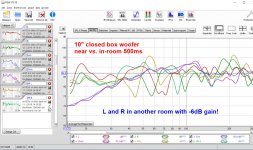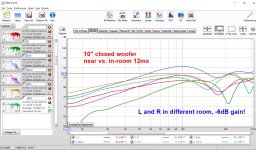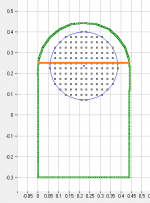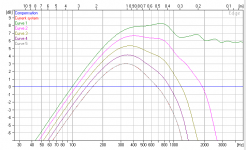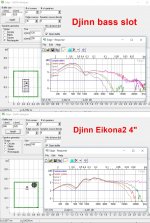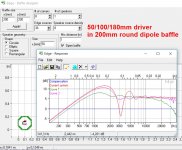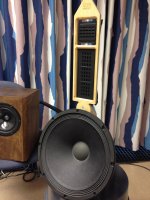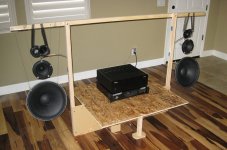I have nagged about measurements, this is why! And this is just a simple 10" closed box downfire woofer. Nearfiel was without eq which is 0,7Q shelf -5dB at 60Hz.
Attachments
Last edited:
^Yes, basically, it happens when front-and backside waves meet at the edge of baffle. Cancellations can not be equalized.
However, depending on baffle shape they get distributed and attenuated. Worst scenario is nude driver or round baffle, when distance from center of driver to edge is constant.
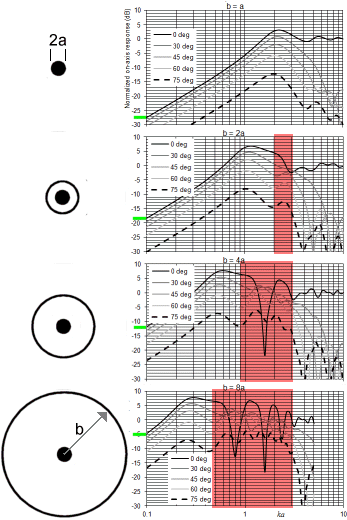
However, depending on baffle shape they get distributed and attenuated. Worst scenario is nude driver or round baffle, when distance from center of driver to edge is constant.

The dipole looses it's constant directivity near the axial null, and above it it's directivity gets narrower, based on driver diameter and profile "normally" but with 90¤ nulling.
This range above dipole on-axis peak and null create the most difficult challenge for the midrange and tweeter, to retain constant directivity profile. The nearness of side walls determines how easily ths is heard.
Here is a good page about these problems
Interim Conclusions
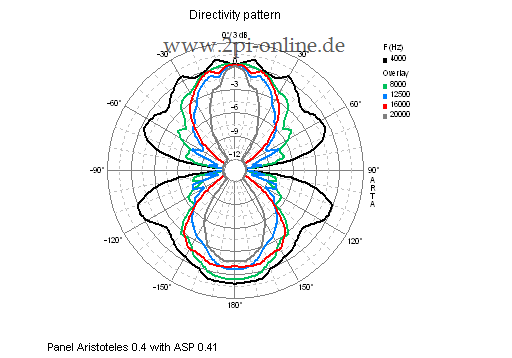
This range above dipole on-axis peak and null create the most difficult challenge for the midrange and tweeter, to retain constant directivity profile. The nearness of side walls determines how easily ths is heard.
Here is a good page about these problems
Interim Conclusions
^Yes, basically, it happens when front-and backside waves meet at the edge of baffle. Cancellations can not be equalized.
However, depending on baffle shape they get distributed and attenuated. Worst scenario is nude driver or round baffle, when distance from center of driver to edge is constant.

Actually, regarding your "worst (case) scenario", I think you will find that the nude driver is "best" and not "worst". Your own plot (taken from SL web page and highlighted in red) shows this.
The problems typically happen only ABOVE the dipole peak in frequency. With the nude driver, the dipole peak is as high as possible. As you move in the direction of a wider and wider baffle (from no baffle), the dipole peak frequency becomes lower and the dips above it become worse. Of course this phenomenon is worst when the baffle is perfectly round, which is what the authors (Mellow and Beranek) chose to use when making their investigation. But the same problems will happen even with rectangular baffles just to a lesser degree.
This is why I try to only use nude drivers whenever possible, except at the lowest frequencies. If I have to use a baffle (e.g. to support the woofer because that is convenient) then I try to size the baffle so that it is not much larger than the driver's frame diameter and/or I place the driver half-in, half-out of the top edge of the baffle.
You can simulate that in the Edge if you use many "edges" for the baffle and drag them so they form a ring around the driver radiating surface protruding above what would be the top edge of a rectangular baffle. The attached pic shows an example of this. I am trying to model a driver in a rectangular baffle that is just about as wide as the driver frame OD, with the driver halfway above the top edge of the baffle. The actual baffle top edge is the orange line. The driver frame OD will be wider than the radiating surface, so the Edge's "baffle" is dimensioned to reflect this. See attached pic. This has a smooth off axis response family, as shown in the attached Edge response plot, with the only notable feature being a narrowing directivity starting around the dipole peak. Compare this model to the upper most plot in the quoted post, above.
With such a minimal baffle, the response is very similar to what I measured for this driver without any baffle at all (nude). Sometimes it is convenient to just bolt the driver to something instead of trying to dangle it in space, and this is what I would use in that case. I find that vibration can be an issue in OBs because they are not all that structurally rigid. By suspending the drivers by wires from an independent frame any vibration transfer (a source of doppler distortion) is eliminated. Also, without large unbraced panels and boxes to resonate, you get rid of a source of coloration.
Attachments
Last edited:
This looks like an extreme attempt to use the baffle to smooth the ripples New OB Project: The Djinn
^I never got answers from matevana at audiocircle, neither does he show any measurements. But Djinn is not perhaps worst scenario... but it obviously has constant dipole radiation pattern only up to 600Hz. The fullrange in the corner suffers from the wide baffle and doesn't show typical dipole pattern at all.
Like Charlie said, a nude round driver has nice response as dipole. Specially, if it is a disc! This is because radiating surface doesn't have constant distance from a radiating point to the edge - sort of smearing of diffraction happens. I made a simulation how driver area changes while baffle size is constant. Because most large drivers are conical and with a motor structure on the convex backside, they don't follow theory perfectly - the worse the smaller they are. I can verify this with numerous measurements that I have made. This is the reason why planar/AMT units are best for dipole in treble range, practically above 2kHz.
Like Charlie said, a nude round driver has nice response as dipole. Specially, if it is a disc! This is because radiating surface doesn't have constant distance from a radiating point to the edge - sort of smearing of diffraction happens. I made a simulation how driver area changes while baffle size is constant. Because most large drivers are conical and with a motor structure on the convex backside, they don't follow theory perfectly - the worse the smaller they are. I can verify this with numerous measurements that I have made. This is the reason why planar/AMT units are best for dipole in treble range, practically above 2kHz.
Attachments
Like many OB speakers it isn't a dipole, designers, probably wisely, are reluctant to call their speakers dipole, and probably an OB speaker is good enough most of the time? I do think much is to be gained from OB bass, more likely to be dipole, and the sonic benefits are more easily realised, aside from the size. I'm not referring to the very low stuff.
........ planar/AMT units are best for dipole in treble range, practically above 2kHz.
That's good to know. Which open back planar/AMT units sound good?
^I have no idea about which are "sounding good", but I like my Bohlender & Graebner Neo8 and Neo3 units. I have zero experience of other brands. My guess is that these sound good, because my speakers were voted to have "Best sound" at a national diy event 
In general, I don't believe in hifi loudspeaker transducers having good or bad sound. They all have measurable spl response, dispersion, distortion, resonances etc. problems, so the designer must work out the best compromise with filtering and crossover.
In general, I don't believe in hifi loudspeaker transducers having good or bad sound. They all have measurable spl response, dispersion, distortion, resonances etc. problems, so the designer must work out the best compromise with filtering and crossover.
..... I like my Bohlender & Graebner Neo8 and Neo3 units. I have zero experience of other brands. My guess is that these sound good, because my speakers were voted to have "Best sound" at a national diy event
Congrats on the DIY award and thanks for sharing your experience. I like the design aesthetics.
I was just looking at the B&G Neo8S specs. What frequency range do you run the Neo8 to sound good, er ... I mean run them within linear capacity as predicted by performance specs and confirmed by measurements
Attachments
Last edited:
That's good to know. Which open back planar/AMT units sound good?
Mundorf has a series of dipole AMTs which are quite nice (and expensive). I am running the cheapers AMT 17D2.2, also used by daudio.nl in their C1 speaker. Their other speakers use the bigger ones.
products | Daudio - dipole – design – audio
My journey with B&G drivers starts from here https://www.diyaudio.com/forums/mul...aborative-speaker-project-35.html#post3676779
Lots of measurements there, and later with Neo3-PDR. Neo8S has more spl capability and is better as dipole than Neo8-PDR that I have. Directivity should be roughly the same, but baffle shape and details are very important! My driver gets in trouble with distortion below 600Hz, it likes LR4 Acoustic, but now it is LR2@800Hz. Above 6kHz it shows lots of response and directivity wiggles. I lowpass it LR2@3,6KHz
B&G went down but there is some production again. Old drivers can be found from eBay and we have copies too, with random quality. Most magnetoplanar/AMT drivers sometimes have a closed back, which can be taken off. Also Beyma TPL and RAAL drivers have been modded to be dipole, but they are too tall for dipole tweeters.
I am excited to see, what drivers Charlie picks up for test and what are his final choices!
Lots of measurements there, and later with Neo3-PDR. Neo8S has more spl capability and is better as dipole than Neo8-PDR that I have. Directivity should be roughly the same, but baffle shape and details are very important! My driver gets in trouble with distortion below 600Hz, it likes LR4 Acoustic, but now it is LR2@800Hz. Above 6kHz it shows lots of response and directivity wiggles. I lowpass it LR2@3,6KHz
B&G went down but there is some production again. Old drivers can be found from eBay and we have copies too, with random quality. Most magnetoplanar/AMT drivers sometimes have a closed back, which can be taken off. Also Beyma TPL and RAAL drivers have been modded to be dipole, but they are too tall for dipole tweeters.
I am excited to see, what drivers Charlie picks up for test and what are his final choices!
^I have no idea about which are "sounding good", but I like my Bohlender & Graebner Neo8 and Neo3 units. I have zero experience of other brands. My guess is that these sound good, because my speakers were voted to have "Best sound" at a national diy event
In general, I don't believe in hifi loudspeaker transducers having good or bad sound. They all have measurable spl response, dispersion, distortion, resonances etc. problems, so the designer must work out the best compromise with filtering and crossover.
Planar magnetic panels do have a particular "sound" in my opinion.
The BG drivers sound excellent, but I would describe them as reserved, distant, polite - also detailed and precise. Dynamic drivers (and AMTs for that matter) sound more up-front and dynamic. I don't know why this is exactly (and I usually avoid using audiophool subjective vocabulary) but there is a difference in presentation inherent in the planar magnetic driver itself.
I am excited to see, what drivers Charlie picks up for test and what are his final choices!
Not sure I will be picking up any new drivers... I already have enough for a couple of dipole systems!
I want to start off by reconstructing the system I build in late 2017 and dismantled for my move last fall. Pic is attached. This uses a 15" nude pro woofer, nude 6" woofer, and the back-to-back tweeter-as-dipole. I previously measured all of these drivers nude, so I know they will work together, but I did not measure them after they were implemented in the nude-hanging system and only threw together a rudimentary crossover. It sounded very promising, however. In the now dismantled system I was experimenting with two 12" subs as a dipole subwoofer, sort of like an H-frame with the sides removed - that is what you see in the middle between the two sets of hanging drivers and below the amps. The subwoofer section supported the two posts, and I used one long crossbar from which the other drivers was suspended. It was certainly very "function before form". What I plan to do instead is to have a central H-frame with an 18" subwoofer and then two flanking speakers that stand on their own. I am trying to dream up a way to have a grille completely around each speaker using some stretched fabric supported by spring wire since otherwise you are looking at some dangling drivers and lumber...
I recently bought some wood and cut some of it on a warm day, but it is the middle of the winter here and I don't really have any kind of workshop at my home. There is no power or heat in my garage either. I will probably be delayed until spring to get things up and running since I have to do my cutting outside and there is currently snow and ice on the ground.
I did buy the material for the central H-frame: it will have a granite top, about 30Wx36D inches, with two sides of butcherblock supporting it. The interior of the opening on front and back will be about 24x24 inches. This is similiar to the prototype I posted about earlier in this thread, just a bit deeper in the front-to-back direction. I only need it to get up to 80Hz-100Hz.
Attachments
Last edited:
you forgot the cabinets.
They're invisible. The patent is pending. Special Romulan cloaking technology. My lawyers told me not to talk about it.
- Home
- Loudspeakers
- Multi-Way
- In Pursuit of a 20-20k Dipole Loudspeaker
